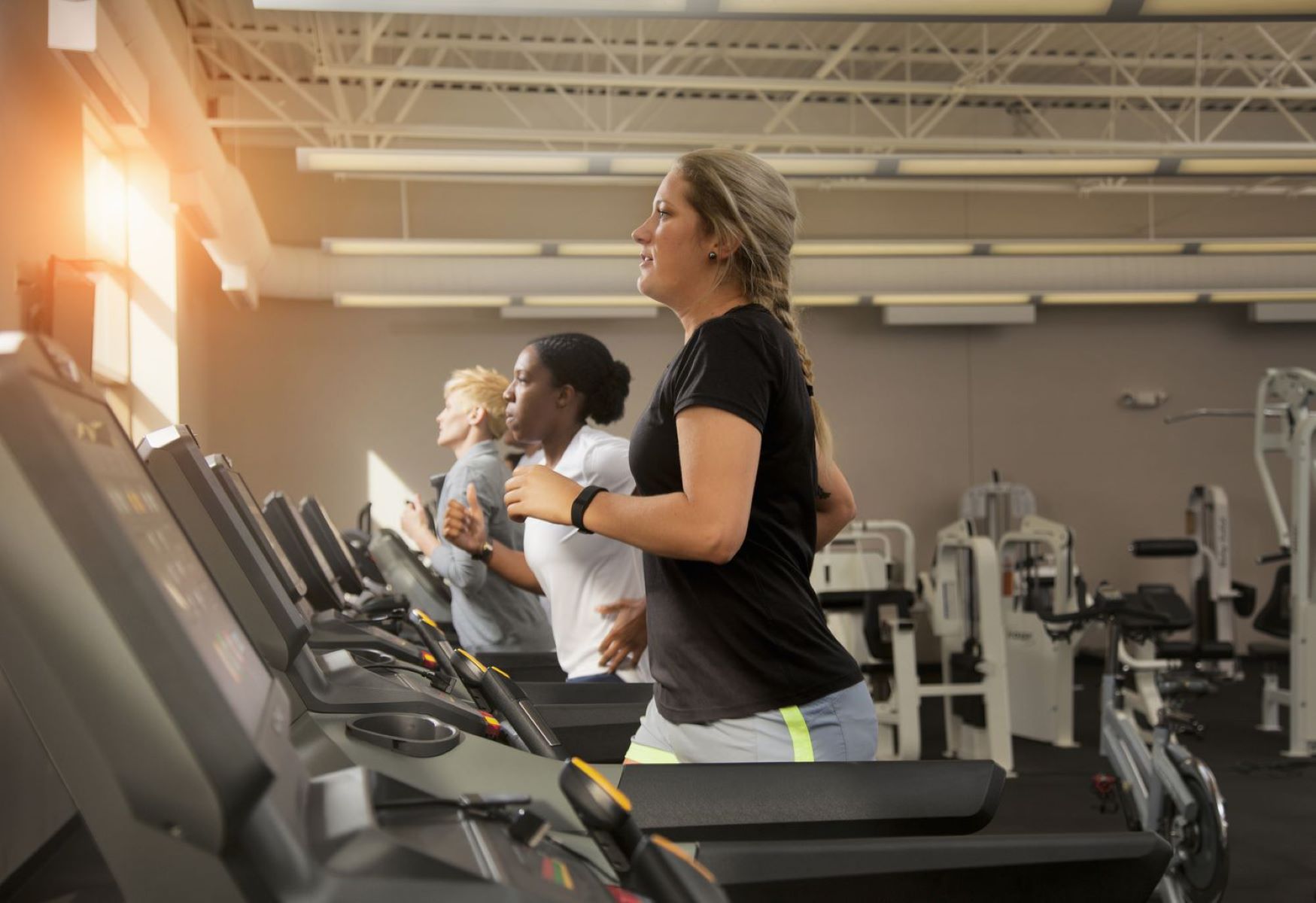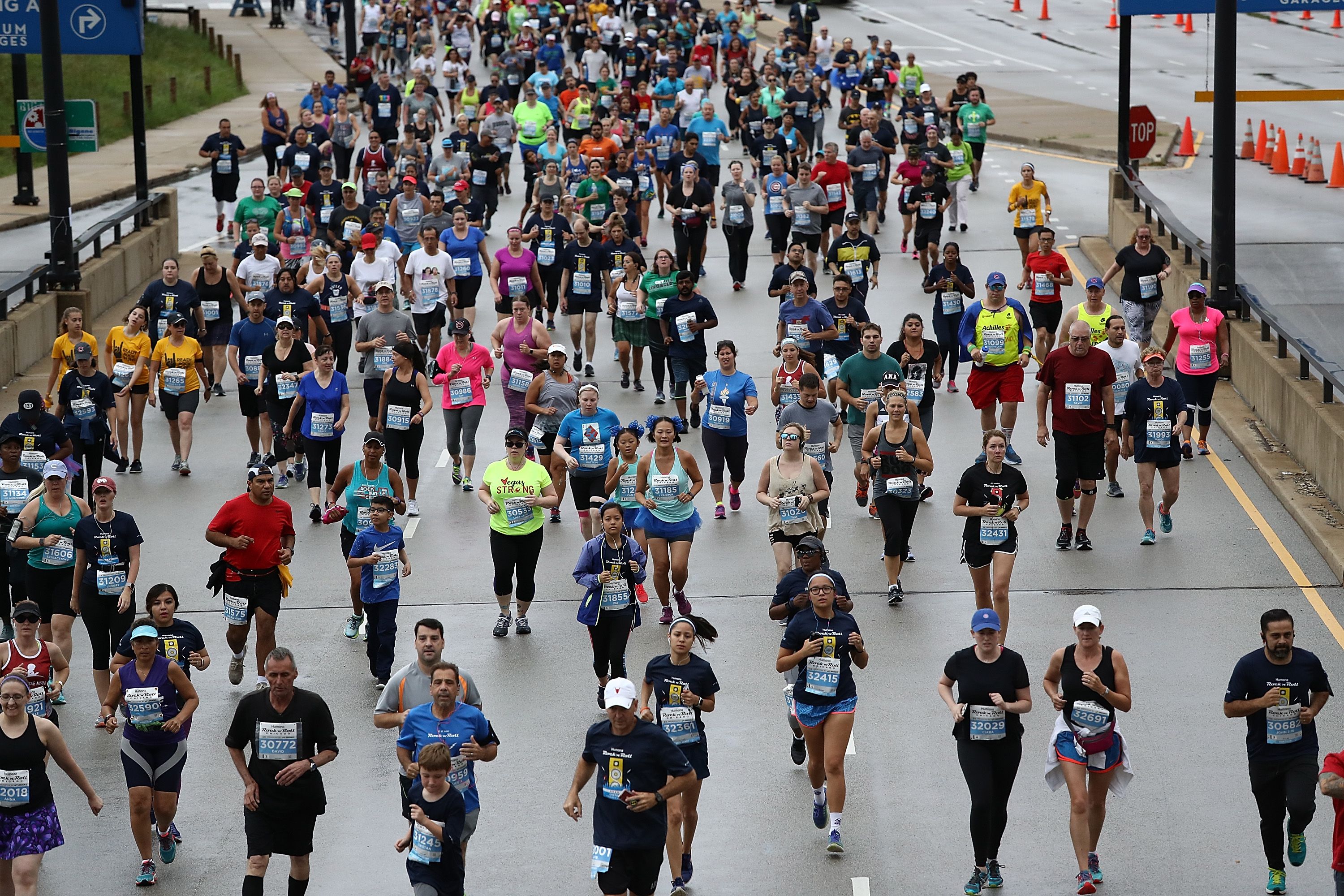

Featured
How To Train For A 5K On A Treadmill
Modified: January 2, 2024
Featured: Train for a 5K on a treadmill with these expert tips and workouts. Achieve your running goals from the comfort of your own home.
Introduction
Do you dream of participating in a 5K race but find it challenging to train outdoors? Don’t worry – you can still achieve your goal by training on a treadmill! Training for a 5K on a treadmill offers numerous benefits and can be just as effective as training outdoors. Whether you’re a beginner or an experienced runner, the treadmill provides a convenient and controlled environment to improve your speed, endurance, and overall fitness.
Training for a 5K race on a treadmill allows you to have complete control over various aspects of your training, such as speed, incline, and duration. This control translates into the ability to customize your workouts to suit your individual needs and goals. Additionally, the cushioned surface of the treadmill reduces the impact on your joints, making it ideal for those who are prone to knee or ankle injuries.
Another advantage of training on a treadmill is the ability to adjust the climate conditions. If you live in an area with extreme weather, training on a treadmill eliminates the challenges of running in sweltering heat or freezing temperatures. With a treadmill, you can train comfortably in a climate-controlled environment all year round.
Additionally, training on a treadmill allows you to monitor and track your progress more accurately. Most modern treadmills come equipped with built-in features such as distance, time, and heart rate monitoring. These essential metrics can help you gauge your performance, set realistic goals, and track your progress as you build endurance and improve your running ability.
Now that you understand the benefits of training for a 5K on a treadmill, let’s explore how to set up your treadmill correctly, establish a training routine, and incorporate essential exercises to help you prepare effectively for your upcoming race.
Benefits of Training for a 5K on a Treadmill
Training for a 5K on a treadmill offers numerous advantages that can help you reach your race-day goals. Here are some of the key benefits:
- Convenience: One of the biggest advantages of training on a treadmill is the convenience it provides. You can work out at any time, regardless of the weather conditions or your schedule. No more worrying about running in darkness or dealing with extreme temperatures.
- Pace and Speed Control: Treadmills allow you to have precise control over your pace and speed. With adjustable settings, you can challenge yourself by gradually increasing your speed as you become more comfortable. This control is particularly beneficial for beginners who are still developing their running skills.
- Safe and Controlled Environment: Treadmill running offers a controlled and safer environment compared to outdoor running. The stable surface reduces the risk of tripping over uneven terrain, and the handrails provide additional security for beginners or those recovering from injuries.
- Joint Impact Reduction: The cushioned surface of a treadmill absorbs impact better than concrete or pavement. This reduces the stress on your joints, making it an excellent option for individuals with knee or ankle issues.
- Progress Tracking: Most treadmills come equipped with features that allow you to track important metrics like time, distance, and heart rate. Monitoring these metrics helps you assess your progress, set realistic goals, and make necessary adjustments to your training program.
- Hill and Incline Training: Treadmills allow you to simulate running uphill, which is a crucial component of 5K training. By incorporating incline settings, you can build strength and endurance, preparing your body for both uphill and flat sections of the race.
- Multi-Tasking: While running on a treadmill, you have the flexibility to watch TV, listen to music, or even read a book. This makes the training experience more enjoyable and can help distract your mind from the physical effort.
Overall, training for a 5K on a treadmill provides a convenient, controlled, and adaptable environment that can enhance your running performance and help you achieve your goals. Now that you know the benefits, let’s dive into how to set up your treadmill and structure your training program for optimal results.
Setting Up Your Treadmill for Training
Before you start your 5K training on a treadmill, it’s essential to properly set up your equipment for optimal performance and safety. Here are some steps to get your treadmill ready for training:
- Placement and Stability: Find a suitable location in your home or gym that provides enough space for the treadmill. Ensure that the area is well-ventilated and away from any potential hazards. Make sure the treadmill is placed on a stable and level surface to prevent wobbling or tilting during your workouts.
- Adjusting the Settings: Familiarize yourself with the various settings on your treadmill, such as speed, incline, and program options. Take some time to explore and understand how each setting works so that you can adjust them according to your training goals.
- Proper Positioning: Stand on the treadmill’s side railings and press the start button to begin. Step onto the belt with one foot at a time and position yourself in the center to maintain balance and stability. Ensure that you have enough space in front and behind you to perform exercises comfortably.
- Initializing the Console: Turn on the treadmill and familiarize yourself with the console. Enter your weight and other required information to ensure accurate calorie and distance calculations. Adjust the display settings and choose a pre-set program or manual mode based on your preferences.
- Safety Features: Pay attention to the safety features of your treadmill, such as a safety key or emergency stop button. Attach the safety key to your clothing to ensure that the treadmill stops automatically if you accidentally trip or fall.
- Proper Footwear: Wear appropriate running shoes with good cushioning and grip to maximize comfort and prevent any slipping accidents. Avoid running barefoot or in unsupportive footwear, as this can lead to discomfort and potential injuries.
Once you have set up your treadmill correctly, it’s time to establish a warm-up routine and incorporate exercises that will help you develop endurance and speed. In the next section, we will discuss some essential warm-up and cool-down exercises to include in your training program.
Warm-up and Cool-down Exercises
Properly warming up your body before a workout is vital to prevent injuries and prepare your muscles for the upcoming intensity. Similarly, cooling down after a workout helps your body recover and prevents post-workout soreness. Here are some warm-up and cool-down exercises to incorporate into your 5K treadmill training:
Warm-up:
- Dynamic Stretching: Begin your warm-up with dynamic stretching exercises to loosen up your muscles and increase blood flow. Perform leg swings, arm circles, knee hugs, and walking lunges to prepare your body for the workout ahead.
- Light Jogging: Start with a slow and easy jog for 5-10 minutes to gradually increase your heart rate and warm up your joints and muscles. Focus on maintaining good running form and breathing rhythm.
- High Knees: Perform high knees by running in place and lifting your knees as high as possible. This exercise helps activate your hip flexors and improves coordination and mobility.
- Butt Kicks: Run in place and kick your heels back towards your glutes. Butt kicks activate your hamstring muscles and increase your range of motion.
Cool-down:
- Walking: After completing your run, gradually bring down your intensity by walking on the treadmill for 5-10 minutes. This helps your heart rate return to normal and aids in the removal of waste products from your muscles.
- Static Stretching: Once your heart rate has normalized, perform static stretches to improve flexibility and reduce muscle tightness. Focus on stretching your calves, quadriceps, hamstrings, hip flexors, and upper body muscles.
- Foam Rolling: Consider using a foam roller to massage and release tension in your muscles. Roll along your legs, back, and other targeted areas, paying attention to any sore or tight spots.
Remember that warming up and cooling down are essential components of your training routine. They help prepare your body for the workout and facilitate recovery, reducing the risk of injury and improving overall performance. With your warm-up and cool-down routine in place, let’s move on to developing endurance on the treadmill.
Building Endurance on the Treadmill
Building endurance is a key aspect of 5K training, as it allows you to maintain a steady pace throughout the race. The treadmill provides a controlled environment to gradually build your endurance and increase your running distance. Here are some strategies to help you improve your endurance on the treadmill:
- Start Slow and Gradually Increase: Begin your training with a comfortable and manageable pace. Focus on maintaining good form and a steady rhythm. As you become more comfortable, gradually increase your running time and distance.
- Consistency is Key: Set aside specific days for your training and commit to them. Aim to run at least three to four times a week to build consistency and gradually increase your overall endurance capacity.
- Interval Training: Interval training is an effective way to improve endurance on the treadmill. Incorporate intervals of higher intensity (such as a faster pace or increased incline) followed by periods of active recovery. This method helps to challenge your cardiovascular system and improve your stamina.
- Progressive Overload: Continuously challenge yourself by increasing the duration or intensity of your runs. Gradually increase your running time, pace, or incline every week to stimulate further gains in endurance. However, it’s crucial to listen to your body and avoid overexertion.
- Long Runs: Incorporate one longer run into your training schedule each week. Increase the duration of your long run gradually to build both physical and mental endurance. These longer runs simulate race conditions and prepare your body for the demands of a 5K.
- Mindful Breathing: Focus on your breathing during your runs. Practice deep breathing techniques to optimize oxygen intake and prevent fatigue. A controlled and rhythmic breathing pattern can help you sustain your energy and improve endurance.
- Track Your Progress: Utilize the features on your treadmill to track your progress. Monitor your running times, distances, and pace to assess your improvements over time. Celebrate your milestones and use them as motivation to keep pushing yourself.
Remember, building endurance takes time and consistency. Be patient with your progress and listen to your body. With dedication and a well-rounded training program, you will gradually improve your endurance and be ready to conquer the 5K race.
Speed and Interval Training on the Treadmill
Speed and interval training are essential components of a well-rounded 5K training program. They help improve your speed, cardiovascular fitness, and overall race performance. The treadmill provides a controlled environment that allows you to easily incorporate speed and interval workouts. Here’s how to effectively implement speed and interval training on the treadmill:
- Warm-up: Begin with a dynamic warm-up routine, as discussed earlier, to prepare your muscles and joints for the upcoming intensity.
- Speed Intervals: Start with a comfortable pace for a designated distance or time. Then, increase your speed to a faster pace for a set duration (e.g., 30 seconds to 1 minute). Return to your original pace for recovery, and repeat the intervals for a total of 5-8 times. Gradually increase the speed or duration of the intervals as you progress.
- Hill Intervals: Adjust the incline on your treadmill to simulate running uphill. Begin with a moderate incline and run at a challenging pace for a specific distance or time. Return to a flat surface for recovery, and repeat the intervals. As your fitness improves, increase the incline and duration of the intervals.
- Fartlek Training: Fartlek, meaning “speed play” in Swedish, involves alternating between periods of fast running and recovery. Incorporate fast bursts of speed throughout your run, followed by slower recovery periods. Vary the intensity and duration of the bursts based on your fitness level and goals.
- Pace Progression: Another effective method is pace progression, where you gradually increase your speed during a run. Start at a comfortable pace and gradually increase your speed every few minutes. This helps simulate the progression of a race and trains your body to maintain a faster pace over time.
- Rest and Recovery: Allow for adequate rest and recovery between interval sessions. Your body needs time to repair and adapt to the increased demands. Incorporate easy runs or low-impact cross-training activities on recovery days to maintain fitness without overexertion.
- Gradual Progression: It’s important to gradually increase the intensity and duration of your speed and interval workouts. Pushing too hard too soon can lead to injuries or burnout. Aim to challenge yourself while still maintaining proper form and avoiding excessive strain on your body.
Speed and interval training on the treadmill can significantly improve your running performance and race readiness. Remember to listen to your body, hydrate properly, and maintain good running form throughout your workouts. With consistent effort and dedication, you’ll witness improvements in your speed, endurance, and overall running ability.
Hill Training on the Treadmill
Hill training is a crucial component of 5K race preparation, as it helps build strength, endurance, and mental fortitude. While running outdoors on natural hills is a great way to train, hill training on the treadmill offers a controlled and convenient alternative. Here’s how to incorporate hill training on the treadmill effectively:
- Warm-up: Before starting your hill training, warm up with a light jog or dynamic stretching exercises to prepare your muscles for the upcoming intensity.
- Gradual Incline Increase: Begin with a flat surface and gradually increase the incline on your treadmill. Start with a moderate incline (e.g., 3-5%) and run at a comfortable pace. Maintain good form with slightly shorter strides and a slightly higher knee lift to adapt to the incline.
- Steady Hill Climb: Once you’re comfortable with the initial inclines, aim for a longer uphill run at a steady pace. Increase the incline to 6-8% and maintain a consistent effort. Focus on your breathing, keep your core engaged, and maintain an upright posture to optimize your hill-climbing form.
- Interval Hill Training: Incorporate interval hill training to challenge your body and enhance your hill-climbing abilities. Alternate between higher inclines (8-10%) for a set duration or distance and a lower incline (3-5%) for recovery. Repeat the intervals 5-8 times, gradually increasing the duration or intensity of the uphill intervals.
- Downhill Running: Don’t overlook downhill running, as it helps develop eccentric muscle control and coordination. Decrease the incline to -1% or -2% and practice controlled downhill running. Focus on a light landing and quick turnover while maintaining stability and balance.
- Hill Sprints: To further challenge yourself, incorporate hill sprints into your routine. Set the treadmill at a steeper incline (10% or higher) and sprint for a short duration (about 20-30 seconds). Rest and recover before repeating the sprint. Hill sprints build both strength and speed, making them excellent for 5K race preparation.
- Progressive Overload: Similar to other training methods, gradually increase the duration, intensity, and frequency of your hill workouts. This progressive overload allows your body to adapt and build strength over time.
Remember to listen to your body and adjust the incline and intensity based on your fitness level. Incorporating hill training on the treadmill challenges your muscles in different ways, preparing you for the varying terrain you may encounter during a 5K race. With consistent practice, you’ll develop the physical and mental strength necessary to tackle hills with confidence and ease.
Incorporating Strength Training for 5K on the Treadmill
Strength training is a crucial component of 5K race preparation, as it helps improve running efficiency, prevent injuries, and enhance overall performance. While the treadmill is primarily known for cardio workouts, it can also be utilized effectively for strength training. Here’s how you can incorporate strength training into your 5K treadmill routine:
- Warm-up: Begin your strength training session with a light warm-up to prepare your muscles for the upcoming exercises. This can include a 5-10 minute jog or dynamic stretching.
- Bodyweight Exercises: Utilize the sides or front of the treadmill for bodyweight exercises. Perform exercises like push-ups, tricep dips, lunges, squats, or planks to engage different muscle groups and improve overall strength.
- Dumbbell Exercises: If you have access to dumbbells or weights, incorporate them into your strength training routine on the treadmill. Perform exercises like bicep curls, shoulder presses, or lateral raises while walking or jogging at a comfortable pace.
- Resistance Band Exercises: Resistance bands are another excellent tool for strength training on the treadmill. Attach the resistance band to the handrails and perform exercises like lateral walks, rows, or chest presses to target specific muscle groups.
- Hill Walking: Increase the incline on the treadmill and walk at a slow but challenging pace. Hill walking engages your leg muscles and helps develop strength and endurance in your lower body.
- Treadmill Sprints: Incorporate short bursts of high-intensity sprints on the treadmill to work on explosiveness and leg power. Increase the speed and sprint for 30-60 seconds, followed by a recovery period. Repeat the sprints for several sets to build cardiovascular fitness and leg strength.
- Core Exercises: Strengthening your core is essential for maintaining stability and proper running form. Incorporate exercises like planks, Russian twists, or bicycle crunches off the side of the treadmill to engage your core muscles.
- Cooldown: Finish your strength training session with a cooldown period to allow your heart rate to gradually return to normal. Perform static stretches to stretch the muscles you’ve targeted during your workout.
Strength training should be incorporated into your overall training program at least twice a week. It’s important to target different muscle groups and focus on exercises that will improve your running economy and help prevent imbalances or weaknesses that can lead to injuries.
By including strength training into your treadmill workouts, you’ll develop a well-rounded training routine that enhances your running performance, improves strength, and reduces the risk of injuries. The combination of cardio and strength training will help you excel in your 5K race.
Rest and Recovery
Rest and recovery are crucial components of any training program, including 5K training on a treadmill. While it may be tempting to push yourself to the limit every day, incorporating adequate rest and recovery periods is vital for optimal performance and injury prevention. Here’s why rest and recovery are essential and how to incorporate them into your training:
The Importance of Rest:
During exercise, your muscles experience micro-tears and stress. Rest days allow your body time to repair and rebuild these tissues, leading to increased strength, endurance, and overall fitness. Rest also helps prevent overtraining and burnout, which can hinder performance and motivation.
How to Incorporate Rest and Recovery:
- Active Recovery: On rest days, focus on low-intensity activities like walking, gentle stretching, or yoga. This promotes blood flow, aids in muscle recovery, and prevents stiffness.
- Listen to Your Body: Pay attention to your body’s signals. If you feel excessively fatigued, sore, or experience any pain, take a rest day or modify your workout. Pushing through excessive fatigue can increase the risk of injury.
- Proper Sleep: Sleep is a critical aspect of recovery. Aim for 7-9 hours of quality sleep each night to allow your body to repair and regenerate. Sleep deprivation can negatively impact performance, recovery, and overall health.
- Nutrition and Hydration: Fuel your body with the right nutrients and stay properly hydrated. Consume a balanced diet rich in lean proteins, complex carbohydrates, and healthy fats to support muscle recovery. Hydrate before, during, and after workouts to replace lost fluids and electrolytes.
- Massage or Self-Myofascial Release: Consider incorporating massage or self-myofascial release techniques like foam rolling to alleviate muscle soreness, increase blood flow, and improve flexibility.
- Periodization: Incorporate periodization into your training plan. This involves alternating between periods of high-intensity and low-intensity training to allow for adequate recovery and prevent overuse injuries.
- Take Rest Days: Schedule rest days throughout your training week. Aim for at least one or two complete rest days, where you take a break from all intense physical activity to allow your body to fully recover and recharge.
Remember that rest and recovery are not signs of weakness but rather essential components of a smart and sustainable training plan. By giving your body the time it needs to recover, you’ll be able to perform at your best during your 5K race and reduce the risk of burnout or injury.
Tips for Successful 5K Training on a Treadmill
Training for a 5K on a treadmill can be an effective and convenient way to prepare for your race. To make the most of your training and ensure success, here are some tips to keep in mind:
- Set Clear Goals: Determine what you want to achieve from your 5K training. Whether it’s improving your speed, increasing endurance, or simply completing the race, having clear goals will help you stay motivated and focused.
- Follow a Structured Training Plan: Use a well-designed training plan that gradually increases your running distance, intensity, and duration. This helps prevent overtraining and ensures a progressive buildup of fitness.
- Mix Up Your Workouts: Incorporate variety into your treadmill sessions to keep your training engaging. Include interval runs, tempo runs, hill workouts, and long steady runs to target different energy systems and improve overall performance.
- Stay Consistent: Consistency is key in 5K training. Aim to run at least three to four times a week, following your training plan and sticking to your scheduled workouts. Consistency builds fitness and helps you develop a routine.
- Monitor Your Progress: Keep track of your running distance, time, and pace. Use the built-in features of your treadmill or a running app to monitor your progress over time. Seeing improvements can provide the motivation and confidence to keep pushing forward.
- Gradual Progression: Avoid pushing yourself too hard too quickly. Gradually increase your running intensity, duration, and speed as your fitness improves. Pushing too hard can lead to injuries or burnout.
- Listen to Your Body: Pay attention to any signs of fatigue, discomfort, or pain. Rest and recover when needed, and don’t hesitate to modify your workouts if something doesn’t feel right. Your body knows best, so prioritize its well-being.
- Proper Nutrition and Hydration: Fuel your body with a balanced diet, including lean proteins, complex carbohydrates, and healthy fats. Stay well-hydrated before, during, and after your workouts to optimize performance and aid in recovery.
- Mental Preparation: Train your mind as well as your body. Practice positive visualization, mental toughness, and focus during your training runs. The mental aspect of running is just as important as the physical.
- Enjoy the Process: Embrace the experience of training for a 5K on a treadmill. Find ways to make it enjoyable, such as listening to music, podcasts, or audiobooks. Celebrate each milestone along the way and remember to have fun!
By following these tips, you’ll be well-equipped to successfully train for your 5K on a treadmill. Stay committed, stay motivated, and trust in the process. With consistent effort and smart training, you’ll be ready to conquer your 5K race with confidence.
Conclusion
Training for a 5K on a treadmill offers a convenient and effective way to prepare for your race. Whether you’re a beginner or an experienced runner, the treadmill provides a controlled environment to improve your speed, endurance, and overall fitness. Throughout this article, we have explored the various benefits of training on a treadmill, the importance of setting up your equipment correctly, and the inclusion of warm-up, cool-down, strength training, and interval workouts. We have also discussed the significance of rest and recovery and provided some helpful tips for successful 5K training on a treadmill.
By utilizing the treadmill for your 5K training, you can enjoy the convenience and controlled environment it offers. You have the ability to adjust running speed, incline, and duration, allowing you to customize your workouts to meet your specific needs and goals. The treadmill’s cushioned surface reduces joint impact, and its climate-controlled setting eliminates weather-related challenges.
To make the most of your treadmill training, it is important to follow a structured training plan, set clear goals, and progress gradually. Incorporating various workouts such as speed intervals, hill training, and strength exercises will help improve your endurance, speed, and overall performance. Additionally, ensuring proper rest and recovery, listening to your body, and maintaining a balanced diet will promote optimal performance and reduce the risk of injuries.
Remember that training for a 5K is a journey that requires dedication, consistency, and resilience. Enjoy the process, stay motivated, and celebrate each milestone along the way. With proper training on the treadmill, you’ll be well-prepared to conquer your 5K race and achieve your running goals.








